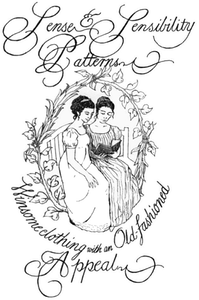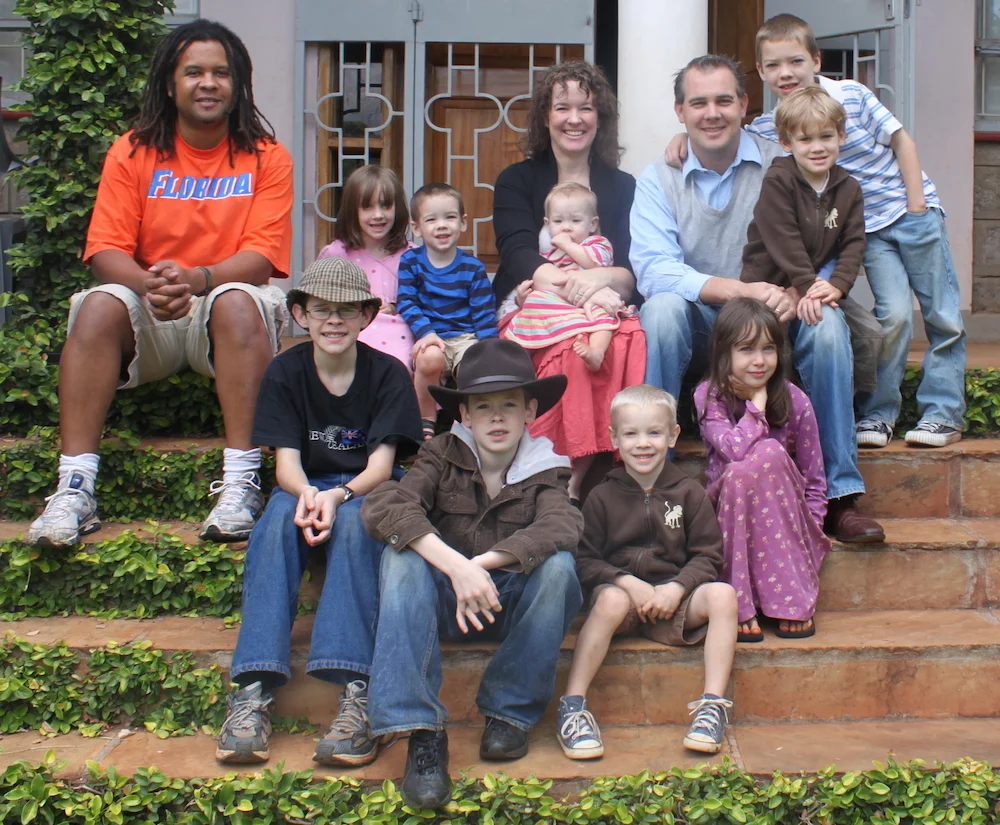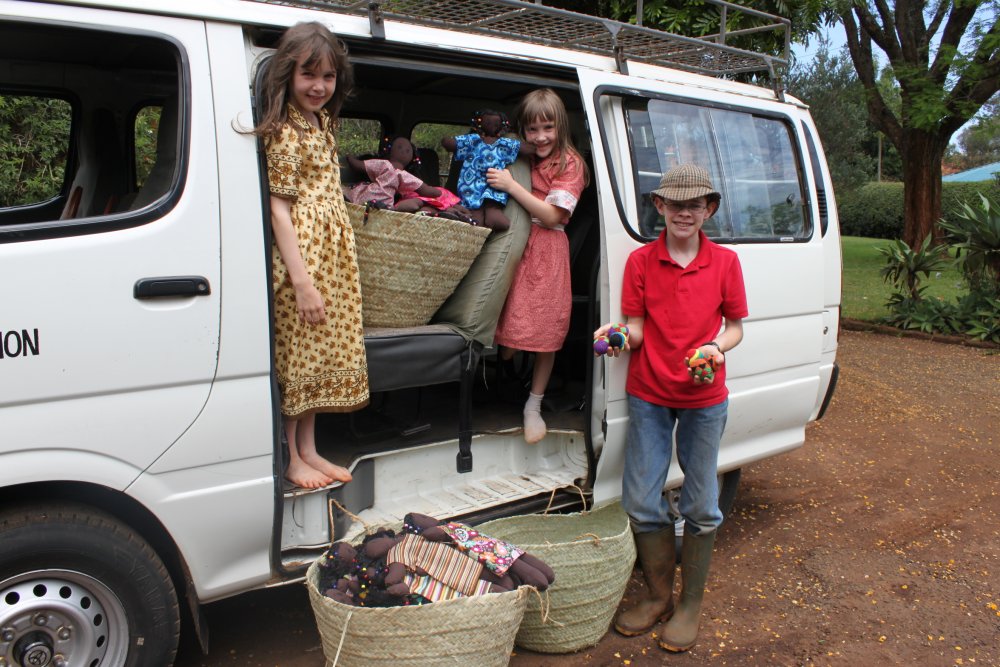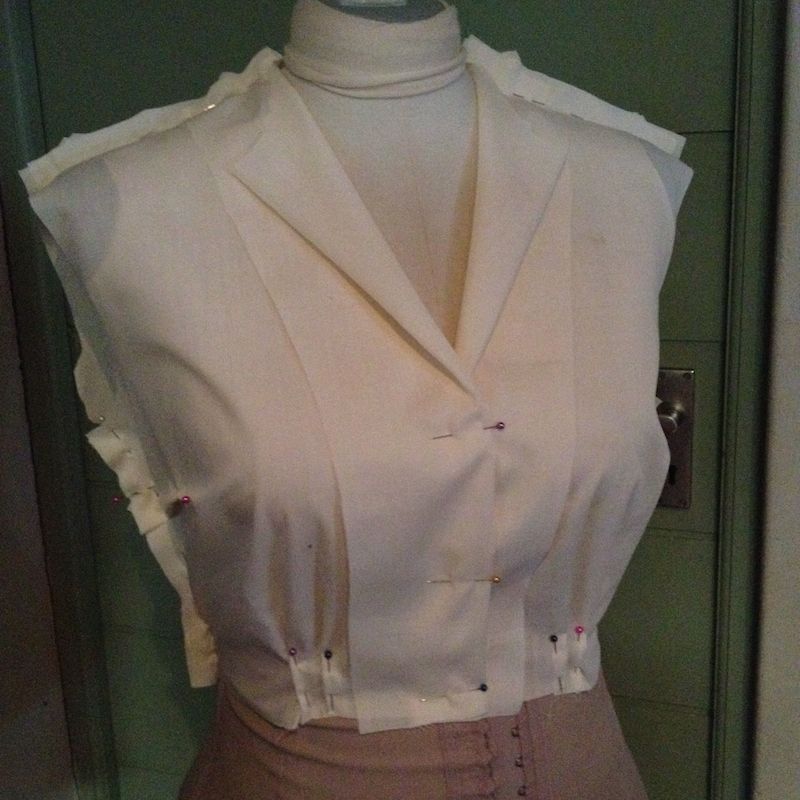The Story of a Pattern...
I've shared in the past how I got into historical fashion and started this business back in 1996, and I've written bits and pieces over the years that offered glimpses into our family's (crazy, unconventional, outside-the-box, adventure-filled) life. Goodness, what a lot we have crammed into the last 21 years! I decided to write this post about the development of my latest pattern, because I think doing so will answer a lot of the questions I've received about what I do and how I do it while bringing up children, homeschooling, and, for the last six and a half years, living overseas. Make yourself a cuppa and settle in; this is going to be longer than the usual 140-character tweet or concise Instagram caption. 😉
In early 2010, while hunting for retro-style dresses that I could wear while nursing my baby daughter, I found a deadstock 1950s shirt dress for sale on eBay. Incredibly, I snagged it for only $25, and it was a perfect fit. I really loved the style with its curved collar, self-cuffed sleeves, and pleated skirt. I'd been telling myself for a couple of years that it was time to branch into 1950s patterns, but I hadn't been struck with inspiration for a new design until I got and wore that dress. Let's face it: there are absolutely tons of 1950s pattern reprints available in the Big Four companies' catalogs, not to mention so many original patterns available for sale at reasonable prices in antiques shops and online. It was going to take something different and fun to convince me to draft a brand new pattern. I wore that dress a lot in 2010, but I never managed to get a photo of myself in it. You'll have to be content with this one taken in 2014 (yes, I love to wear 1950s dresses when I ride my vintage Schwinn!).
My husband’s work took our family on a brand new adventure to Kenya in 2011, which meant six months of serious downsizing, planning, packing, and a round of visits to the extended family to say farewell. My hubby had been back and forth to Kenya and South Sudan for five years, and we were all excited to finally join him and set up a home base closer to the work. I lovingly packed up all my sewing and drafting tools along with the school books and clothes and treasures we didn’t want to leave behind us. We got the kids color-coordinated shirts for our journeys through four airports on three continents (yes, I’m that mom!). Without a single hitch or lost bag, we made our way from Alabama to DC to London to Nairobi, enjoying the mouths hanging agape at the sight of nine children in red tee shirts following their parents through security and customs. Thanks to a wonderful helper who traveled with us, it was the smoothest trip ever (I love you, Mercy!). When the authorities in Nairobi Airport saw all the children, the chief guard looked at my husband, then me, then asked, “Where is the other wife?” My husband grinned and pointed at me. Floored, I said, “I'm the only wife and mother!” The guard broke into a huge smile and called over his fellow security officers to meet our family before waving us through and calling out, “God bless!” Kenyans are warm and lovely people, and this first experience was a predictor of the friendly welcome we would all receive throughout our time in that country.
When we first arrived, we stayed in the house of a Kenyan-American who had also grown up in a big family and loved ours. He was a computer animator and graphics designer and was fascinated to hear about my pattern business. He told me I should consider starting up a sewing and design class for Kenyan ladies. I tucked that information away to mull over later and dove into getting to know our new surroundings and meeting locals. Kenya was a kaleidoscope of beautiful colors and music and tribes and languages. We took the children to feed giraffes and pet baby elephants. We visited Karen Blixen’s stunning homestead in the Ngong Hills. We bought all our produce from roadside stands and learned how to cook new dishes like sukuma wiki and ugali. It was a glorious immersion into a new culture with lots of wonderful friends to help us settle in. Below is a little slideshow to give you a taste of those first months in Nairobi.
[gallery type="slideshow" link="file" size="large" ids="12178,12195,12115,12185,12196,12193,12144,12142,12194,12159,12148,12120"]I strove to keep us on as normal a schedule as possible so the children would feel a sense of home and belonging. We continued our usual daily routine of schoolwork in the mornings, lunches together, then reading aloud in the early afternoons. Every other week or so, we'd go on an outing, but with terrible roads and a city choked with traffic, we did most of our "journeys" within three miles of home! Thankfully, our section of Nairobi had lots to do, from visiting the flip-flop recycling project to watching artisans produce beautiful Kazuri beads. We spent evenings at home, often having people over for meals, hosting the church Bible study, and sitting around by lamplight when the power went out. Swatting mosquitoes also became something of a sport for my children before they retired into their mossie nets to sleep each night. It was definitely an adventure!
My husband introduced me to a Kenyan couple who run a school and medical clinic in Nairobi’s largest slum, Kibera. The wife knew about my love for sewing and told me she wanted to start up a guild to train women to sew all kinds of things that they could sell to help support themselves. She didn’t have the funding to buy sewing machines or tools and asked how I could help. I hit upon the idea of selling the gorgeous Kanga fabrics I saw daily in the markets to raise money and had our wonderful helper carry home a couple of trunks bulging with them to sell on eBay and Etsy. Then I began looking seriously at what women wore in Kenya to figure out what I could teach that would also sell well in the Kenyan market and perhaps even back in the U.S.
While Kenya has adopted a lot of Western fashions, there is still a preference for the fabrics and styles that originate in East Africa. Kenyan women adore the classic 1950s hourglass silhouette as much as I do, so I thought of my vintage 1950s shirt dress done up in Kitenge fabrics and wrap skirts made from Kangas. Those would be the perfect learning tools for a class. I began work on a new pattern inspired by my original dress, but teaching would have to wait until the birth of our tenth child, who arrived in October that year.
[gallery type="slideshow" link="file" size="large" ids="12143,12116,12128,12150,12171"]
A couple of months later, we were ready to roll. The funds from the sale of the Kangas had purchased several brand new treadle sewing machines, which are far more practical in a city where power cuts are a constant reality. 25 women showed up at the first class, and I began by teaching them how to make simple, A-line skirts from gorgeous Kanga panels. Halfway through the class, the power went out, but we sailed right on! Next time, I showed my students the shirt dress and taught them how to make an accurate copy without taking the dress apart, and they eagerly got to work. Two of the ladies had taken garment cutting classes in school (a part of home ec, which I think is fabulous!). Those gals really led the others along when I couldn’t be with them, and a dedicated core group of women began turning out lovely dresses and skirts.
[gallery type="slideshow" link="file" size="large" ids="12177,12176,12175,12174,12173,12182,12179"]
At home, I stayed busy teaching my children and welcoming guests, including my mother-in-law, who came to visit and brought trunks of hand-sewn dolls that would be used in the Kibera school. In spare moments, I worked on fine-tuning the ladies' pattern inspired by my original dress and had it all finished and ready for the printer in December 2011. Then disaster struck. We took our children away after Christmas to visit the coast, leaving a house sitter to hold the fort for a week. My pattern was safely rolled up in my sewing cupboard, or so I thought. Unfortunately, our guest (bless his heart!) took the 12-cup coffee machine out of the kitchen and put it on my cupboard. He overfilled it, then left it to bubble over all down the insides of the cabinet. I returned home to find my pattern sheets (not to mention a lot of beautiful fabric) totally ruined by the hot coffee spill. Devastated, I just couldn’t face doing the work all over again. It felt like something had died—all that effort over the months…lost. I salvaged what I could of my original test bodices and sleeves and folded them away for a future date.
A very dear friend of mine got married in 2012, and I wanted to surprise her with a retro going away outfit. I pulled out my vintage magazine and pattern stash for inspiration and created a pencil skirt shirt dress with detachable cuffs and collar dickie—something quite different from the pattern inspired by my dress. A lot of love went into that ensemble, and I shipped it off with a Kazuri bead necklace and bracelet to match. Then I decided it was time to do something totally different, so I began work on an Edwardian Underthings pattern (which Suzi Clarke had been after me to create for at least five years!). I got the pattern pieces made and tested, then began work on the instructions. Right at the point of adding in the illustrations, my computer crashed due to a faulty anti-virus program, utterly wiping out my hard drive. Had I backed it up? Nope. That was a very painful lesson to learn. I bought a backup drive and got a DropBox account to insure against future losses! (And, no, I haven’t finished re-writing those pattern instructions yet…gulp.)
Our life in Kenya continued to roll along, and several of our children had the opportunity to go with their dad on some of his work trips. After listening to our oldest sons complaining about how they hated the constant power outages and potholed roads and lack of playgrounds and other amusements, we took both of them to volunteer in the school in Kibera slum, sharing their love of LEGO™ with children who had never seen the bricks before and kicking off a hands-on educational program that is still running today. Our sons played and built with the kids for hours and came back different boys. We all learned to see the world through new eyes while working with Kenyans from all different parts of society, and we grew to love the people who became part of our everyday lives.
[gallery link="file" size="large" type="slideshow" ids="12137,12136,12135,12127,12131"]
In between all the homeschooling and work and play in 2012, I sewed a lot for my girls, which is what so often leads to new pattern ideas! Inspired by a 1958 pattern illustration, I stitched up two dresses for my girls that became the Girls’ 1958 Party Dress pattern, followed quickly by the ladies’ version. We had a colleague who would be traveling back the States, and I could send those pattern sheets off with him in a mailing tube to my printer to be scanned (there were no large-format scanners in Nairobi at the time, and shipping a tube home would have cost about $450—ouch!). That gave me a hard deadline I had to meet, and nothing seems to spur me on like a panic-attack deadline! I finished both patterns in record time and also sent the Edwardian Undies pattern sheets for a scan, knowing I’d eventually rewrite the instructions!
I played around with ideas for a girls' shirt dress pattern and made a bunch of different ones for my girls that year. They wore them constantly, passing them down to the next sister as they outgrew them. I still have them packed away for my littlest daughters to enjoy one day! I loved the look and feel of these dresses and set aside all the finished pattern pieces I'd drafted to create a pattern "one day." 2012 was super busy with a visit from my folks and taking a tour group to England in September with my second-eldest son. While my mother was in Kenya, she also taught a class in Kibera, and the ladies loved her hugs and praises (my mom is famous for hugs and kind words!). The ladies in the sewing guild kept sewing, and we bought more machines (including an industrial overlocker) from the proceeds of more Kanga sales.2013 was a big year in Kenya, as the national elections took place in March. Our Kenyan friends worried there might be a repeat of the 2007 election violence, and we sincerely hoped all would remain calm. Our family started a bakery as a way to teach a group of women how to bake and sell cinnamon rolls in the local markets, and that took up my "extra" time, so I shelved work on new patterns for the time being. I visited the States briefly early in the year to go through the things we had stored and ended up downsizing even more (something about living abroad really motivated me to get rid of stuff, I tell ya!). I packed up the rest of my vintage sewing manuals and patterns and took them back to Nairobi with me. In September, I took another group over to England, accompanied by my eldest son. It was actually a huge relief to be out of Kenya during that tense time. Even though the elections had gone quietly, prices had soared, and Kenyans were hurting as a result. Regulations handed down by the new government also made it much harder for small NGOs to work in the country, and many moved out to Uganda or Tanzania. Insecurity plagued the larger cities, and burglaries rose sharply.At the end of my England trip, I caught the news on television and was horrified to see the Westgate Shopping Centre under attack and in flames. My husband often met his boss for coffee there, as it was a central location in the city. I quickly called home and was shaken to learn that my husband's boss had been on his way to that coffee shop with his daughter on the morning of the attack but had suffered from a stomach bug and turned around to go home instead. One of his daughter's classmates wasn't as fortunate. Her father was shot and killed, and she was wounded in the attacks. My husband's work permit was up for renewal shortly after this devastating event, and the corrupt bureaucracy drastically increased the fees to renew it. We decided to take a sabbatical in the Western Cape of South Africa to get our bearings and figure out what to do next.
After locating a rental house and flying the family down, we made new friends and kept in touch with our loved ones back in Kenya. The children had to get used to the fact that they could venture outside our front gate any time they wanted to (we live in a very small village with low crime). We welcomed our fifth daughter in May and celebrated new life and a new country. It was a time of adjustment, but we quickly fell in love with the village and its people and decided to stay longer, since my husband could still "commute" to the field as needed.
[gallery type="slideshow" link="file" size="large" ids="12152,12157,12153,12151,12145,12134,12129,12125,12123,12110,12138"]
Now that things had settled down to normal, I pulled out my sewing things and eased back into creativity with a tutorial for the Girls' 1780s Portrait Dress pattern. I also tidied up and laid out the Girls’ Classic 1950s Shirt Dress pattern sheets, which rekindled my determination to make a ladies’ pattern. I got back to work but deviated from the original design and went with something closer to the girls’ version. I made a lot of progress, but when I got to the point of making model dresses, I just wasn’t thrilled. The design didn’t have the unique charm of that original deadstock dress, nor was it as comfortable to wear. So I set it aside and focused on other things. My eldest daughter decided at that time to make a "Cinderella" ballgown for a homeschool dance, and we spent a couple of weeks buried in masses of chiffon and tulle! After teaching a teenage neighbor how to make circle skirts in early 2016, I felt my 1950s itch coming back, so I put together a free tutorial to make those iconic skirts. Then I pulled out my original deadstock dress and one of the Kenyan versions I loved to wear and realized this was the design I really wanted to get back to for a new 1950s pattern.
Jump ahead, over another England tour and morning sickness, and I was in the second trimester of pregnancy and feeling quite energetic (this is normal with me, in case you hadn't noticed! 😂). During the long Christmas break, I redrafted the pattern and made myself a maternity version of the shirt dress, which confirmed my deep love for this particular dress. After that, I was off and running and rapidly decided I could marry this pattern to the going-away dress I'd made for my friend in 2012 and come up with an omnibus pattern that would include a pencil skirt option, a detachable peplum, and even a separate blouse that could be worn with a skirt. In record time, I had a working pattern with many more options than I had originally intended. I sent it off to the laser plotter for grading, wrote and illustrated the instructions, then got my testers on board to try the sizes and make sure they worked. After about a month of chatting back and forth with those ladies, I made the needed tweaks and had everything "put to bed" before our new baby arrived in April. I had hoped to launch the pattern before his appearance, but he unexpectedly arrived on his due date (usually I get an extra week--LOL!), so I settled into a wonderful, month-long babymoon.
I was full of plans to get the pattern finalized and launched by mid-June, but our landlord announced she'd decided to sell the house we were renting, and we had to act fast to find another and move our entire household by the end of June. Nothing like a bit of insanity mid-year to keep those brain cells working! No sooner had we settled in than a very dear family friend lost her long battle with liver cancer, and we gathered around her family to grieve and remember. My husband had to travel for two weeks in August. I always tell myself I'll use my evenings while he is away to finish up projects, but, truth be told, I usually end up crashing into bed after a day of parenting solo. 😜 Before I knew it, August was gone, and September was trying to run away from me. My mother-in-law arrived for her yearly visit and she and my husband packed me off to her cottage for a full day of uninterrupted work on photo editing, prepping the website, and writing my eNewsletter. And that's how I got to today--the official launch of this new pattern!
A lot of water has gone under the bridge since I first had the inspiration for this pattern, but I think you can see this is really a story about life--not just my work on a particular pattern. My husband and I have always tried to keep our faith, our marriage, our family, and our children at the top of our list of priorities. I know I won't look back in twenty years and wish I'd published twice as many patterns, but I would definitely regret missed opportunities to speak into the lives of these young people in my charge. There are times I've definitely failed and floundered, but the one major piece of advice that has held true over the years is, "There are seasons in life; work within them." A mother of ten told me this way back in 2003, urging me not to try to take on too much while my oldest children were tiny but to pace myself and live intentionally in each season. There's a famous passage in the book of Ecclesiastes about this:
For everything there is a season, and a time for every matter under heaven: a time to be born, and a time to die; a time to plant, and a time to pluck up what is planted; a time to kill, and a time to heal; a time to break down, and a time to build up; a time to weep, and a time to laugh; a time to mourn, and a time to dance; a time to cast away stones, and a time to gather stones together; a time to embrace, and a time to refrain from embracing; a time to seek, and a time to lose; a time to keep, and a time to cast away;a time to tear, and a time to sew; a time to keep silence, and a time to speak; a time to love, and a time to hate; a time for war, and a time for peace. (Eccl 3:1-8, ESV)
We aren't meant to sow and reap in the same season, and we save ourselves a lot of frustration if we trust this and stop trying to cram everything onto our plates at once. Figuring out how to slot creative work and a small business into the round of daily life, babies, toddlers (!!!), young adults, etc. is an art that we learn over a lifetime--not a skill we can pick up on the fly by reading the right how-to books (though there are lots of helpful ones!). You find what works for your own family, and when it isn't working, you stop, evaluate, and reboot. There's no shame in that and no last-place ribbon if you have to take time off for any reason.
So, yes, at last this six-year-long pattern story has a happy ending. The bumps on the road were part of the process, as what would have been a fairly basic pattern turned into an omnibus, thanks to ideas gleaned over the years and things I learned while wearing many test dresses (POCKETS!). I couldn't have done it without my amazing husband, who has taken the littles and gifted me with alone-time on days when I really needed to focus and push through a certain stage of the work. I couldn't have done it without the sharp eyes and patience of my pattern testers in four different countries (thank you, ladies!). I definitely couldn't have done it without the encouragement of my wonderful customers, who have always cheered me on, even as I've missed yet another promised deadline. You are GOLD STAR human beings! I hope you enjoy using the Ladies' Classic 1950s Wardrobe pattern, and keep those emails and photos coming!





















